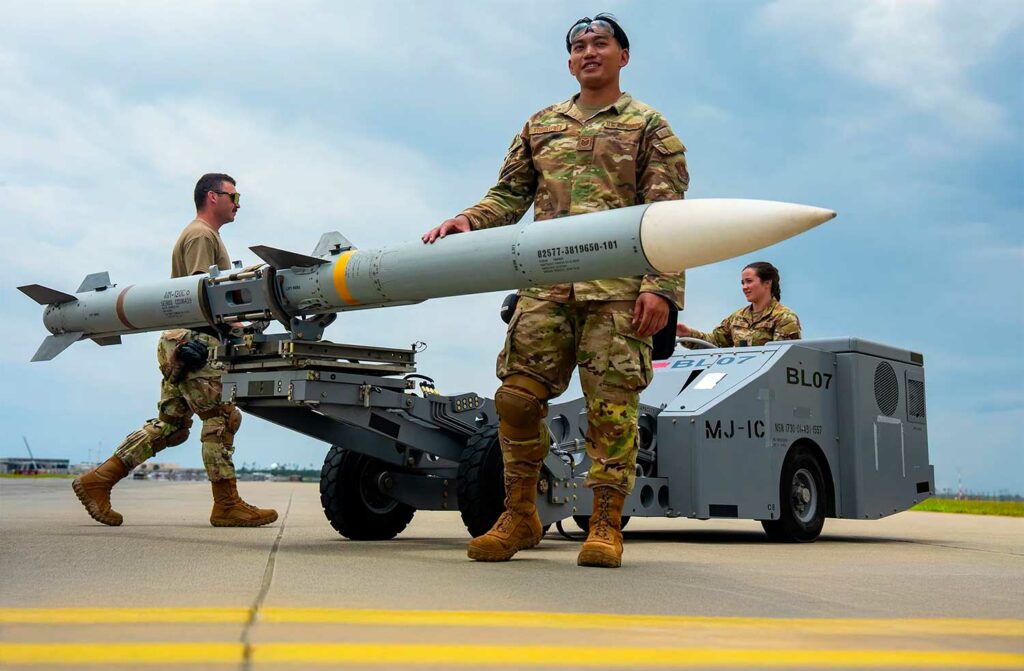
The United States has signed a $3.5 billion contract to produce AIM-120 missiles for 19 countries amid growing military tensions.
On July 31, 2025, the Pentagon approved an exceptional order from Raytheon for the mass production of AIM-120 AMRAAM air-to-air missiles. The contract is worth $3.5 billion. Never before has such a large order been placed for a single series of missiles of this type. The objective is clear: to urgently replenish the stocks of the US military and its allies, while anticipating future needs in the event of military escalation. Nineteen countries, including Japan, Germany, Poland, the United Kingdom, Australia, Israel, Ukraine, and the Netherlands, will benefit from this production, which also includes spare parts, telemetry systems, and logistical support.
In a context marked by intensifying hybrid threats, widespread attacks by cheap drones and pressure on stocks of modern missiles, this contract illustrates the US strategy: to produce proven ammunition quickly and in large quantities. The AIM-120, an active radar-guided missile, remains the backbone of medium-range air defense in the Western camp.
An unprecedented order with multiple beneficiaries
The $3.5 billion covers production batches 39 and 40 of the AIM-120, although no precise figure for the number of missiles involved has been released. The unit price of an AIM-120 varies depending on the version, but regularly exceeds $1 million, especially for recent variants such as the AIM-120D-3. It can therefore be estimated that the contract covers several thousand units, intended for national air forces but also for ground-based systems such as NASAMS.
The list of recipients includes NATO member countries such as Germany, Norway, the United Kingdom, the Netherlands, and Poland, as well as strategic partners such as Japan, Israel, Australia, and Ukraine. The principle is that of Foreign Military Sales, which allows the Department of Defense to organize bulk orders for several customer countries.
The AIM-120 missile is compatible with almost all Western fighter jets, from the F-16 to the F-35, including the Typhoon and Gripen. It is also used on NASAMS ground-to-air systems, which are now in service in more than 15 countries.
Intensive operational use and stockpile crisis
This contract comes at a time when AIM-120 stocks are under pressure. Ukraine has used a significant number of these missiles in the defense of its territory, particularly through the deployment of NASAMS systems. Since 2022, these missiles have been used against Iranian Shahed drones, Russian cruise missiles, and approaching aircraft.
At the same time, Israel has used these munitions against Houthi and Iranian drones over the Red Sea and the Golan Heights. In Iraq and Syria, US forces have also used them to protect their bases.
This consumption is compounded by normal wear and tear during training and insufficient production rates in recent years. The US itself has acknowledged that its air-to-air missile stocks are not sufficient for a major conflict. Current production does not cover annual expenditure, which has led to the activation of dormant production lines and the resumption of subcontracting for certain critical components.

Technical characteristics and planned developments
The AIM-120 AMRAAM (Advanced Medium-Range Air-to-Air Missile) is a fire-and-forget system, i.e. capable of reaching a target without continuous guidance from the firing fighter. It is equipped with an active X-band radar, an inertial autopilot, and a data link system that allows it to be redirected in flight.
The most recent version delivered in series is the AIM-120D-3, capable of reaching a target at a range of over 160 km depending on engagement conditions. It has better jamming resistance, greater terminal maneuverability, and improved accuracy.
Raytheon is also working with the Air Force Life Cycle Management Center on the next version, known as the AIM-120E, whose exact specifications remain classified. In addition, a separate program—the AIM-260 JATM—is under development to meet longer-range requirements, particularly against Chinese J-20 fighter jets and long-range threats.
Industrial challenges and logistical issues
One of the major obstacles to a rapid resumption of production is the complexity of the supply chains. The missile is composed of high-density electronic components, tactical rocket engines, active radar guidance, and protected communication systems. Some subassemblies require more than 18 months to manufacture.
The current US effort aims to triple annual production capacity by increasing investment in critical lines and securing the supply of strategic materials. Several European countries are also considering internalizing part of their production or building up national buffer stocks.
Growing dependence on the US system
This mega-order also reflects a strategic choice: rather than massively diversifying missile systems within the allied forces, the US is consolidating a widely used and interoperable standard. This has logistical advantages but raises questions of sovereignty.
Countries such as France and Germany are also looking at alternatives: the Meteor missile, developed by MBDA, offers a longer range and an active data link until impact. However, it is more expensive and less widely available. Delays in the delivery of new European missiles explain the almost systematic use of the AIM-120 in recent crises.
The contract signed with Raytheon aims to respond to a tactical emergency: not to run out of critical ammunition in a context where conventional conflicts are returning to the forefront. The AIM-120 missile remains the benchmark for Western air forces for air-to-air combat and short- to medium-range air defense.
But this centralization of production raises long-term concerns. The ability to replenish stocks, vulnerability to strained supply chains, and technological dependence on US industry are all points of weakness.
There is no guarantee that the production committed to in 2025 will be sufficient to meet requirements in the event of high-intensity warfare against a well-equipped state adversary. Consumption figures in Ukraine and the Middle East already provide a glimpse of this. If states want to maintain a credible deterrent capability, they will have to go beyond the logic of bulk purchasing and invest in diversifying their arsenals and production chains.
War Wings Daily is an independant magazine.